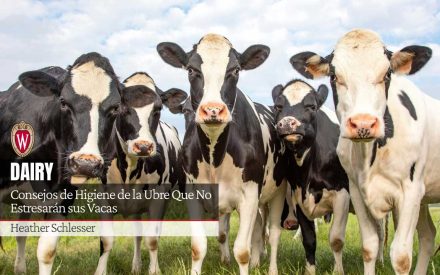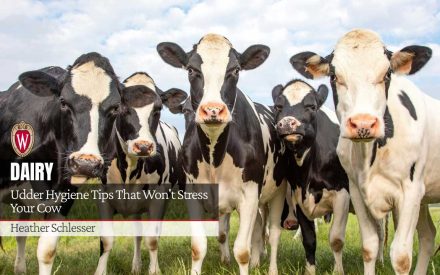Hoof health is essential for not only the overall health of the animal, but also for her welfare. Digital dermatitis (DD), or hairy heel warts, is an extremely painful condition for dairy cattle, reducing their ability to walk to and from the milking parlor, or to the feed bunk. Based on USDA NAHMS 2017 data, 16.8% of all cows and 2.6% of bred heifers have lameness on a dairy operation.
Just like a mature milking cow, heifers are not immune to DD. Digital dermatitis is the highest cause of lameness in bred heifers, with 70.9% of all heifer lameness contributed to DD, more so than in the lactating herd where it was reported DD infected 36.0% of lame cows.

Impact of digital dermatitis in heifers
UW School of Veterinary Medicine research supports the negative impacts of DD on health, milk production, and reproductive performance during the first lactation of a heifer diagnosed with DD pre-calving. The cost of DD can range between $3 and $239, based on individual first-lactation milk yield, per heifer. Digital dermatitis in heifers leads to an increase in DD events during the first lactation. Based on a study by A. Gomez (2015), 45.6% of heifers having a DD event during the first lactation had at least one DD event before calving and increased to 67.6% of heifers during their first lactation if they had two or more DD events before calving.
Prevention and control of DD within the lactating herd starts with the replacement herd. Young, pre-calving heifers go through several changes in terms of movement and regrouping into breeding, post-breeding, pre-fresh, calving, and post-fresh pens. University of Wisconsin School of Veterinary Medicine’s Dr. Dörte Döpfer indicates it is around the breeding age, 12 to 14 months, when the maximum peak of active DD lesions occur in the pre-calving heifer. If not properly managed, a chronically DD infected dairy replacement herd can increase the DD pressure of the lactating herd once they calve, even if the lactating herd has a well-managed DD prevention and control program.
How do heifers get DD
The environment predisposes heifers to the pathogen, Treponema sp. Many times, pre-calving heifers are not in optimal housing, and may be found in calving pens that neighbor sick and/or dry cows. Facilities may be older, repurposed housing for heifers with cleanliness and ventilation challenges. Heifer barns may not be cleaned as often, or overstocked, providing an abundance of manure, moisture, and exposure of pathogens to the feet.
Digital dermatitis control in pre-calving heifers is the best chance for prevention and control of DD in lactating cows. Keeping the feet as clean and dry as possible minimizes the amount of organic matter and possible pathogen load on the feet. Alleyways may need to be scraped more often or stocking density reduced to lessen the amount of manure in the alleys. Additional bedding, lower stocking density, and properly sized stalls will encourage heifers to lay in stalls for long periods.
Detection
Penn State’s Dr. Jud Heinrichs suggests evaluating the prevalence of DD in heifers at the time, or shortly after, calving. If more than 5% (ideally less than 1%) of heifers have DD lesions at calving, evaluate the heifer program for DD onset and prevention in heifers.
Dr. Döpfer states when going on the DD hunt, conduct pen walks, looking for active DD lesions on the rear feet. Start with the oldest heifer pen and work toward the youngest aged heifers to find the source of infection. Identify the pen of heifers with the maximum prevalence of active DD, those animals acutely lame with large ulcerative lesions. There may be heifers in the older groups who may have chronic DD, with occasional flare-ups of active lesions, but the key is to look for the pen or age group where the highest prevalence of active lesions is occurring. Once the pen has been identified, calculate the age of heifers 60 to 90 days earlier and look at this age group. This is the pen where DD prevention and control measures, such as foot baths, topical treatment, and cleanliness, must start.
Treatment and control
Digital dermatitis is extremely difficult, if not impossible to eliminate, therefore the focus should be on managing and controlling DD. Footbaths do not cure, rather, they are a management practice designed to maintain existing DD in an inactive state (Stage M4). Treating active (Stage M2) DD lesions on individual heifers reduce the reservoir of infection which in turn reduces the incidence of spreading the Treponema sp. pathogen to other herd mates.
Acute lesions should be detected early and immediately treated topically with oxytetracycline through a valid Veterinarian-Client-Patient-Relationship (VCPR). One should not wait for days or weeks until the next hoof trimming, as this allows the heifer to spread Treponema sp. pathogen to others and within the environment. The first treatment may be the only opportunity to heal the active M2 lesion and turn it into clean skin or a non-active M4 lesion. The lesion should be cleaned and dry, removing all organic matter. Many facilities are not equipped to handle individual applications for heifers, therefore work with the herd veterinarian and team to determine the best course of treatment application.
Copper sulfate footbaths are utilized to help maintain and control chronic DD lesions in an inactive (M4) state, thus preventing the spread of DD to noninfected animals. However, footbaths are not always the easiest to implement or maintain in a heifer facility. Footbaths can be an excellent way to prevent DD. However, if not properly maintained footbaths can be a source of trouble regarding hoof health. Footbaths not mixed to the proper pH can do more harm than good to foot skin health. Also, if not removed after use, footbaths can serve as a source of contamination from manure and urine collected between treatments.
Feeding trace minerals have been shown to improve hoof health and the overall immune function of the heifer. The improved condition of the skin around the hooves and the general hardness of the hooves helps to reduce the incidence of DD.
Hoof health starts with the heifer and begins with an ongoing prevention and control system to prevent, manage, and control the impact of DD in the milking herd.
Download Article

 ▶️ Watch: Confort y diseño de instalaciones en granjas lecheras
▶️ Watch: Confort y diseño de instalaciones en granjas lecheras Consejos de Higiene de la Ubre Que No Estresarán sus Vacas
Consejos de Higiene de la Ubre Que No Estresarán sus Vacas Udder Hygiene Tips That Won’t Stress Your Cow
Udder Hygiene Tips That Won’t Stress Your Cow Proteger el ganado lechero: Manejo Seguro de Agujas y Productos Veterinarios Inyectables
Proteger el ganado lechero: Manejo Seguro de Agujas y Productos Veterinarios Inyectables


